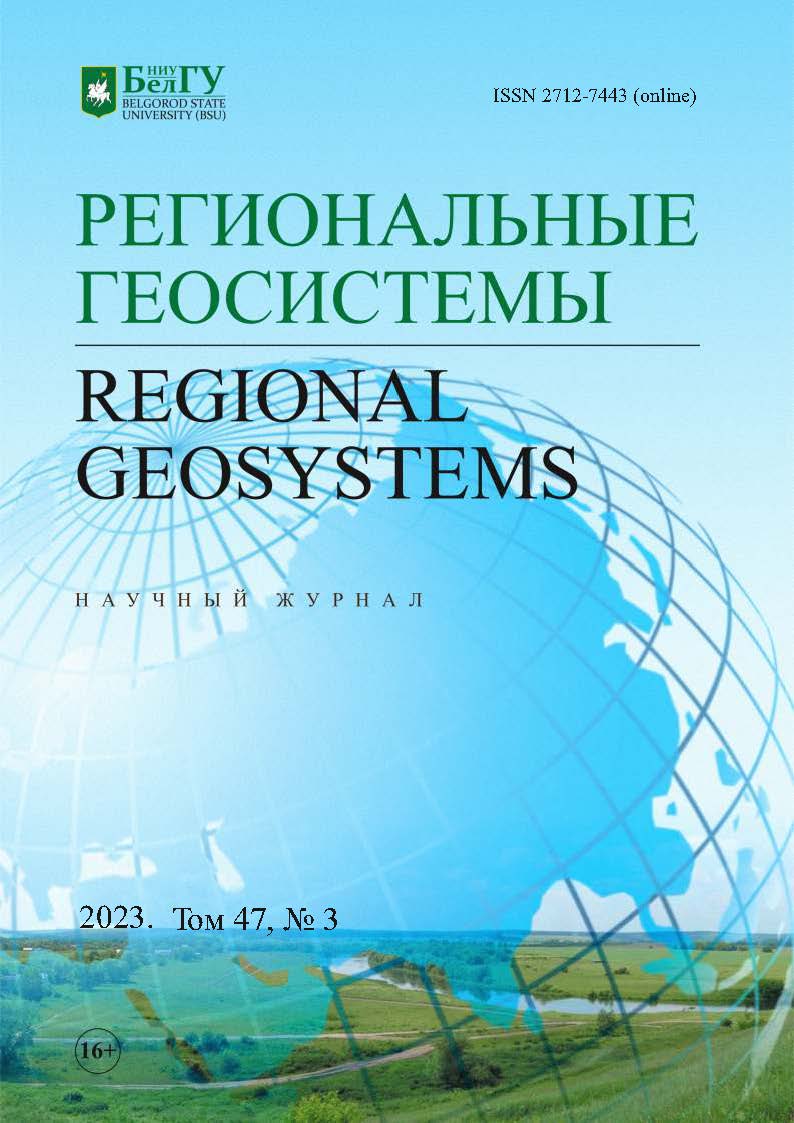Agricultural Land of the Osa River Basin: Use and Level of Fertility
DOI:
https://doi.org/10.52575/2712-7443-2023-47-3-392-405Keywords:
soils, agriculture, fallow land, fertility, mappingAbstract
In 2013–2023 studied the physicochemical properties of natural and agrogenic soils of active and fallow agricultural land of the Osa river basin in the Irkutsk region. A map of the use of land has been drawn up. It was revealed that more than 80 % of agricultural land is occupied by deposits. Mapping of soils of agricultural land and usable land was carried out. It has been established that under arable land there are low-productive highly densified overcompacted soils with a low thickness of the humus horizon, which occupy about 2 % of all agricultural land in the study area. Soils used for arable land have a lower humus content compared to natural analogues. High humus concentrations were found, located within the «above average» range, in the sod horizon of soils of a 15-year deposit. However, medium to very low concentrations of mobile forms of phosphorus were found in the arable horizon of the deposit soils. The content of mobile forms of potassium in soils is characterized as low and above average. It has been established that over time, the content of humus in the fallow soil approaches the background level, but phosphorus and potassium fertilizers are required to increase soil fertility. On fallow lands, the restoration of the agronomically valuable soil structure is observed. A map of recommended goals (preservation, development, refusal) of soil use has been compiled.
Acknowledgment. The study was carried out with the financial support of the Russian Science Foundation and the Ministry of Economic Development and Industry of the Irkutsk Region (Project No. 23-27-10013 (05-62-629/23) "Transformation of Post-Agrogenic Soils and the Possibility of Their Introduction into Agricultural Circulation in Conditions of Intensive Environmental Use and Global Environmental Changes").
Downloads
References
Список источников
Агрохимическая характеристика почв сельскохозяйственных угодий и рекомендации по применению удобрений в ООО «Бильчир» Осинского района Иркутской области. 2009. Ред. Бутырин М.В. Иркутск, ФГБУ ЦАС «Иркутский», 29 с.
Аринушкина Е.В. 1970. Руководство по химическому анализу почв. М., Издательство Московского университета, 487 с.
Атлас. Иркутская область: экологические условия развития. 2004. М., Иркутск, 90 с.
ГОСТ 5180-84. Грунты. Методы лабораторного определения физических характеристик. Электронный ресурс. URL: https://meganorm.ru/Index2/1/4294853/4294853441.htm (дата обращения: 15.08.2023)
ГОСТ 29269-91. Почвы. Общие требования к проведению анализов. Электронный ресурс. URL: https://internet-law.ru/gosts/gost/5323/ (дата обращения: 15.08.2023)
ГОСТ 26212-91. Почвы. Определение гидролитической кислотности по методу Каппена в модификации ЦИНАО. Электронный ресурс. URL: https://internet-law.ru/gosts/gost/10397/ (дата обращения: 15.08.2023)
ГОСТ 26213-91. Почвы. Методы определения органического вещества. Электронный ресурс. URL: https://okhotin-grunt.ru/gost/%D0%93%D0%9E%D0%A1%D0%A2_26213-91.pdf (дата обращения: 15.08.2023)
ГОСТ 26207-91. Почвы. Определение подвижных соединений фосфора и калия по методу Кирсанова в модификации ЦИНАО. Электронный ресурс. URL: https://internet-law.ru/gosts/gost/38473/ (дата обращения: 15.08.2023)
ГОСТ 26488-85. Почвы. Определение нитратов по методу ЦИНАО. Электронный ресурс. URL: https://files.stroyinf.ru/Data2/1/4294827/4294827941.pdf (дата обращения: 15.08.2023)
ГОСТ 26489-85. Почвы. Определение обменного аммония по методу ЦИНАО. Электронный ресурс. URL: https://docs.cntd.ru/document/1200023496 (дата обращения: 15.08.2023)
Кузьмин В.А. 2004. Почвенный покров. Атлас Иркутской области. Иркутск-Москва, 40–41.
Экологический атлас бассейна озера Байкал. 2015. Ред. В.М. Плюснин. Иркутск, Институт географии им. В.Б. Сочавы СО РАН, 145 с.
Экологический атлас Байкальского региона. 2017. Электронный ресурс. URL: http://atlas.isc.irk.ru (дата обращения: 15.08.2023).
Физико-химические методы анализа в агрохимии. 1990. М., Агрохимиздат, 303 с.
Список литературы
Агрохимические методы исследования почв. 1975. М., Наука, 656 с.
Аристовская Т.В., Чугунова М.В. 1989. Экспресс-метод определения биологической активности почв. Почвоведение, 11: 7–15.
Калеп Л.Л. 2003. К проблеме экологизации аграрного землепользования Байкальской природной территории. География и природные ресурсы, 2: 41–44.
Макеев О.В., Корзун М.А., Ногина Н.А., Уфимцева К.А. 1961. Почвенное районирование Байкальской Сибири. В кн.: Почвенное районирование СССР. Москва, Издательство Московского университета: 146–206.
Воробьева Л.А. 2006. Теория и практика химического анализа почв. М., ГЕОС, 400 с.
Титлянова А.А. 2018. Методология и методы изучения продукционно-деструкционных процессов в травяных экосистемах. В кн.: Биологическая продуктивность травяных экосистем. Географические закономерности и экологические особенности. Новосибирск, ИПА СО РАН: 6–14.
Убугунов Л.Л. 2020. Почвенные ресурсы республики Бурятия, их агроэкологическое состояние и рациональное использованию. Вестник Бурятской государственной сельскохозяйственной академии им. В.Р. Филиппова, 2(59): 35–46. DOI: 10.34655/bgsha.2020.59.2.005
Шпедт А.А., Козлова А.А., Белозерцева И.А., Гранина Н.И., Лопатовская О.Г., Киселева Н.Д., Куклина С.Л., Мартынова Н.А., Лопатина Д.Н. 2022. Почвенно-экологическая оценка сельскохозяйственных земель Красноярского края, Иркутской области, Республики Бурятия. Земледелие, 1: 9–13. DOI: 10.24412/0044-3913-2022-1-9-13
Geist H.J., Lambin E.F. 2002. Proximate Causes and Underlying Driving Forces of Tropical Deforestation. BioScience, 52(2): 143–150. DOI: 10.1641/0006-3568(2002)052[0143:PCAUDF]2.0.CO;2
Godfray H., Beddington J., Crute I., Haddad L., Lawrence D., Muir J., Pretty J., Robinson S., Thomas S., Toulmin C. 2010. Food Security: the Challenge of Feeding 9 Billion People. Science, 327(5967): 812–818. DOI: 10.1126/science.1185383
Prishchepov A.V., Müller D., Dubinin M., Baumann M., Radeloff V.C. 2012. Determinants of Agricultural Land Abandonment in Post-Soviet European Russia. Land Use Policy, 30(1):
–884. DOI: 10.1016/j.landusepol.2012.06.011
Saraykin V., Yanbykh R., Uzun V. 2017. Assessing the potential for Russian grain exports: a special focus on the prospective cultivation of abandoned lands. In: The Eurasian Wheat Belt and Food Security: Global and Regional Aspects. Ed. by Gomez y Paloma S., Mary S., Langrell S., Ciaian P. NewYork, Springer Cham: 155–176.
Abstract views: 176
Share
Published
How to Cite
Issue
Section
Copyright (c) 2023 Regional Geosystems

This work is licensed under a Creative Commons Attribution 4.0 International License.


